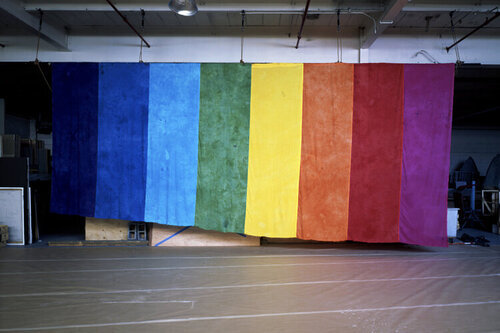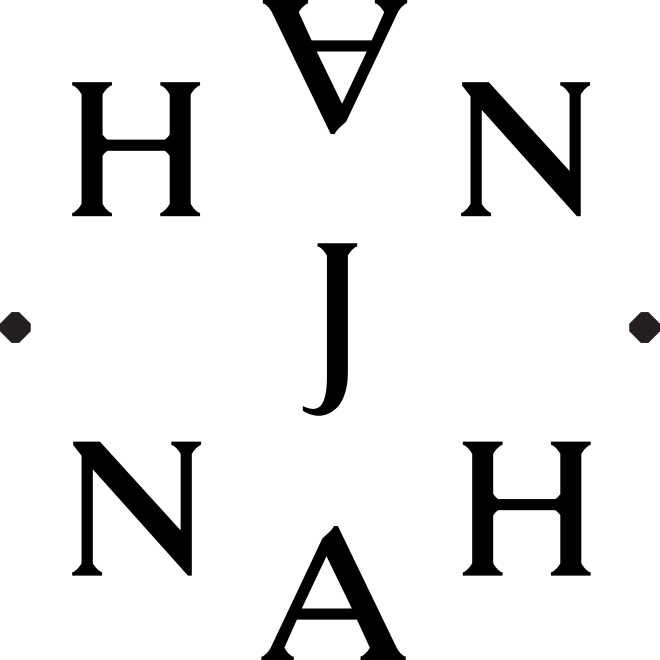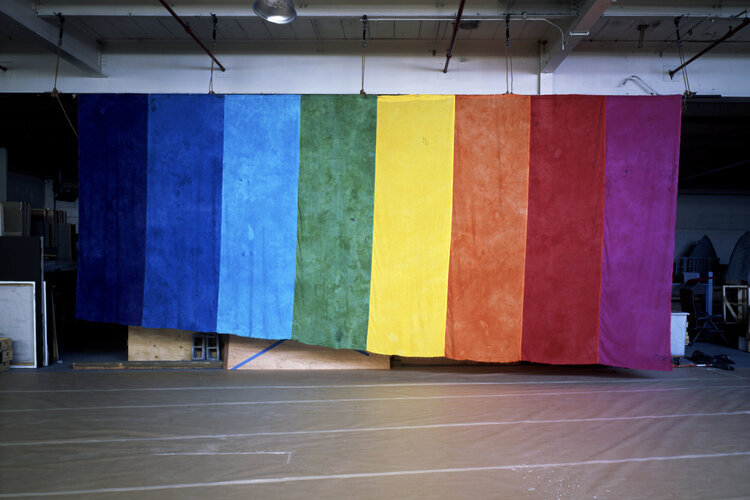JH Color Theory: Flags of Pride

A look at how the multi-colored flag(s) of Pride emerged as colorful, affirmative symbols of equality and proclamations of visibility.
Nalda Rodriguez, wearing a rainbow dress and lying on the grass at the 25th annual Gay Pride celebration, Piedmont Park, Atlanta, Georgia, June 25, 1995
"Flags are soaring symbols of pride and community, as well as emotional, incendiary sparks for those on the other side of the barricade. They are among the most immediate, primal, and communicative forms of design.”
— Paola Antonelli, MoMA’s Senior Curator of Architecture and Design
On June 25, 1978, the first and original rainbow flag was raised at the United Nations Plaza in downtown San Francisco. Its creation was a departure from the most popular queer symbols that shaped the political momentum of the LGBT rights movement at that time.
Lynn Segerblom in 1978 with original eight-color flag behind her at UN Plaza in San Francisco. (James McNamara)
The idea for the pride flag had been incubating since 1976 by the artist Gilbert Baker:
One of the original eight-color flags flying at United Nations Plaza in San Francisco during Gay Freedom Day 1978. This hybrid of the rainbow and American flags was designed by Gilbert Baker’s close friend Lynn Segerblom. Photograph by Crawford Wayne Barton; Crawford Wayne Barton Collection (1993-11), GLBT Historical Society.
”And I thought, a flag is different than any other form of art. It’s not a painting, it’s not just cloth, it is not a just logo—it functions in so many different ways. I thought that we needed that kind of symbol, that we needed as a people something that everyone instantly understands [...]
What the rainbow has given our people is a thing that connects us. I can go to another country, and if I see a rainbow flag, I feel like that’s someone who is a kindred spirit or [that it’s] a safe place to go. Its sort of a language, and it’s also proclaiming power. That’s the phenomenal [aspect] of it.”
— Gilbert Baker in an interview for the MoMA Archives with Michelle Millar Fisher about the origin story of his iconic creation
With the assistance of other members of San Francisco’s 1978 pride parade decorations committee, the original flag was hand-dyed and stitched together at the Gay Community Center at 330 Grove [Street] in San Francisco.
"We needed something beautiful — something from us, and the rainbow is so perfect because it really fits our diversity in the sense of our race, our gender, all of those things, our ages… Plus, it’s a natural flag — it’s from the sky…" said Gilbert.
The original eight colors* represented different spiritual and emotional elements of the psyche. Hot pink stood for sex; red for life; orange for healing; yellow for sunlight; green for nature; turquoise for magic and art; indigo for serenity; and violet for spirit.
*In 1979, the pink and turquoise stripes were dropped from Baker’s version due to challenges obtaining pink fabric and having an odd number of colors. The resulting six-stripe flag is one of many iterations of flags you see today.
Replica of the original eight-color rainbow flag design. Image c/o Art and Artifacts Collection, GLBT Historical Society.
Progress Pride Flag designed by Daniel Quasar.
The pride flag is ultimately ubiquitous, dynamic, and flexible. Since 1978, a number of adaptations and additions have been made to the original design to represent the intersectionality of queerness and its subcommunities. The modern "Progress Pride Flag," redesigned by LGBTQ+ activist Daniel Quasar in 2017 adds stripes for trans people and people of color.
"The rainbow flag is an utterly analog yet highly interactive object — a flag only flies on the wings of wind or human hands, or else it collapses into limp fabric — that speaks to and with people powerfully.” – Maria Popova, "MoMA Acquires the Rainbow Flag as a Design Icon: A Conversation with the Artist Who Made It"
The mile-long rainbow flag being carried down First Avenue in New York City. At the bottom of the image is the segment of the flag cut for the St. Patrick’s Cathedral protest. Photograph by Mick Hicks
"Whoever you are, YOU are an authority on being queer. And, no matter what, you are not alone in the grand scheme of history. The battles for queer liberation have been waged by people of every background, with every body type, of every color, educational pedigree, socioeconomic status, gender identity, and physical and mental ability." – Leighton Brown and Matthew Riemer, creators of Instagram account @lgbt_history for them.










